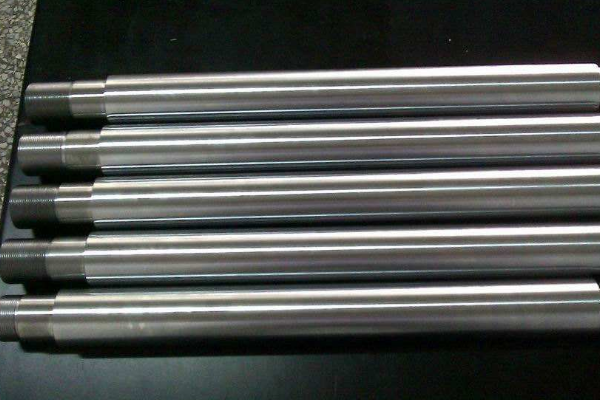Chrome Piston Rod: a connecting part that supports the work of the piston. Most of it is used in oil cylinders and cylinder motion execution parts. It is a moving part with frequent movement and high technical requirements. Take a hydraulic oil cylinder as an example, which is composed of a cylinder barrel, a piston rod (Hard Chrome Plated Rod), a piston, and an end cover. The quality of its processing directly affects the life and reliability of the entire product. The piston rod has high processing requirements, and its surface roughness is required to be Ra0.4~0.8um, and the requirements for coaxiality and wear resistance are strict. The basic feature of the cylinder rod is the processing of a slender shaft, which is difficult to process and has always troubled the processing personnel.
The material of the Chrome Plated Steel Rod of the hydraulic cylinder is 45# steel, which is quenched and tempered, and the surface is turned and ground and then plated with chromium to a thickness of 0.03~0.05mm.
The Ck45 Chromed Piston Rod is a connecting part that supports the work of the piston. Most of it is used in oil cylinders and cylinder motion execution parts. It is a moving part with frequent movement and high technical requirements. Take a hydraulic cylinder as an example, which is composed of a cylinder barrel, a piston rod (cylinder rod), a piston, and an end cover.
Hard Chrome Plated Piston Rod the quality of its processing directly affects the life and reliability of the entire product. The piston rod has high processing requirements, and its surface roughness is required to be Ra0.4~0.8μm, and the requirements for coaxiality and wear resistance are strict.
We also can offer stainless steel piston rod.
Hard Chrome Piston Rod:Stainless steel piston rods are mainly used for piston rods for hydraulic and pneumatic, engineering machinery, and automobile manufacturing. The piston rod is processed by rolling. Because the surface layer leaves the surface residual compressive stress, it helps to close the micro cracks on the surface and hinder the expansion of corrosion. Thereby improving the surface corrosion resistance, and can delay the generation or expansion of fatigue cracks, thereby improving the fatigue strength of the cylinder rod. Through roll forming, a cold work hardened layer is formed on the rolled surface, which reduces the elastic and plastic deformation of the contact surface of the grinding pair, thereby improving the wear resistance of the cylinder rod surface and avoiding burns caused by grinding. After rolling, the surface roughness value is reduced, which can improve the mating properties. At the same time, the friction damage to the sealing ring or the sealing element during the movement of the cylinder rod piston is reduced, and the overall service life of the cylinder is improved. The rolling process is a high-efficiency and high-quality process measure. The rolling head (45 steel seamless steel tube) with a diameter of 160mm is now used as an example to prove the rolling effect. After rolling, the surface roughness of the cylinder rod is reduced from Ra3.2~6.3um before rolling to Ra0.4~0.8um, the surface hardness of the cylinder rod is increased by about 30%, and the surface fatigue strength of the cylinder rod is increased by 25%. The service life of the oil cylinder is increased by 2 to 3 times, and the efficiency of the rolling process is about 15 times higher than that of the grinding process. The above data shows that the rolling process is efficient and can greatly improve the surface quality of the cylinder rod.
Post time: Aug-10-2021




